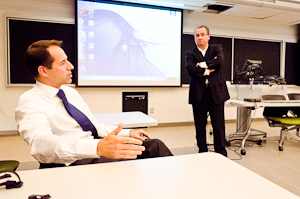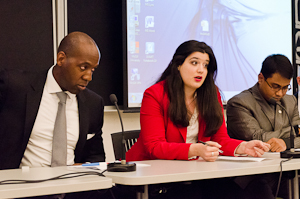IASL hosts a symposium on “Emissions Trading and International Civil Aviation: Making the Links & Lessons Learned”
 . |
.  . |
.  |
Canada’s aviation industry is in for a bumpy ride. As the world scrambles to meet its Kyoto commitments, a recent European move has created turbulence for practitioners of air law and emissions control law, and the skies ahead look anything but clear.
With this in mind, key players of the international civil aviation industry gathered at McGill’s New Chancellor Day Hall on October 5, for a day-long symposium to discuss the legal issues around the new Directive from the European Union Emissions Trading Scheme (EU ETS), which seeks to control carbon emissions from international flights.
Attended by 90 participants, the closed-door symposium brought together airline representatives, federal and provincial government officials, lawyers from firms specialized in aviation law, international experts in emissions trading and leading academics. It was co-hosted by McGill’s Institute of Air & Space Law (IASL) and Centre for International Sustainable Development Law (CISDL), the International Emissions Trading Association (IETA), the German Embassy, Bennett Jones LLP and SNC Lavalin.
Aviation accounted for only three percent of global carbon emissions in 2009 but, according to an IETA brief presented to conference-goers, the industry’s carbon footprint increased by 98 percent between 1990 and 2006, and is expected to grow by a whopping 667 percent by 2050. The EU directive is one attempt to tackle this problem.
“The new rules apply to all planes, including Canadian planes, landing in Europe,” explained Professor Armand de Mestral, a former acting director of the IASL who teaches Public International Air Law and holds the Jean Monnet Chair in the Law of International Economic Integration.
As it stands, airlines have been given an emissions allowance by the EU, and will soon be required to pay a penalty for exceeding that cap. Imposing CO2 penalties is nothing new: it exists in many industries producing greenhouse gas emissions, and has given rise to the profitable field of carbon trading.
In this case, however, a legal battle arose over the EU’s plan to charge airlines for emissions produced over the entire span of the flight, including the distance outside their jurisdiction. So, for a flight from Montreal to Paris, Air Canada would have to pay for emissions calculated over 5530 Km, not just the fraction that falls within European airspace. Lawsuits were launched by several American airlines, then dropped after December 21, 2011, when the EU’s highest court ruled that the ETS Directive does not violate EU law and can proceed.
This issue is controversial enough to lead, potentially, to a legal impasse that could paralyze international aviation as we know it. Potential solutions to this impasse were explored during a debate between students and graduates from the IASL and the CISDL. Verki Tunteng (BCL/LLB’ 10), an associate at Heenan Blaikie and research fellow at the CISDL, argued that the European scheme should be respected, while Tanveer Ahmad and Isavella Maria Vasilogeorgi, two doctoral candidates at the IASL, presented the more international position, that unilateral European action is not the way to go.
“The ideal,” according to Vasilogeorgi, an Eric J.C. Arsenault Fellow in Space Governance who is currently working jurisdictional issues relating to hybrid aerospace vehicles at the IASL, “is to create a global policy for everyone.”
The morning of the symposium was devoted to the closely connected issue of carbon trading, focusing particularly on Quebec’s cap-and-trade program and the nascent carbon market in Quebec. “In Canada, Quebec is a leader in promoting and adopting rules for carbon trading,” said de Mestral.
What this means is that companies whose total carbon emissions come in below the state-imposed cap can sell their extra emission permits, also known as carbon credits, to companies that exceed the cap. This trade in carbon credits has given rise to an international commodity market in emissions permits. Today, even non-emitters can bid for credits and trade them on the open market.
“Lawyers need to know about these issues, because in their careers they’re going to have to deal with carbon trading, and these rules on emissions are going to have to be enforced,” remarked de Mestral. “It’s a big issue affecting us all.”
– Story by Bridget Wayland
– Photos by Lysanne Larose
